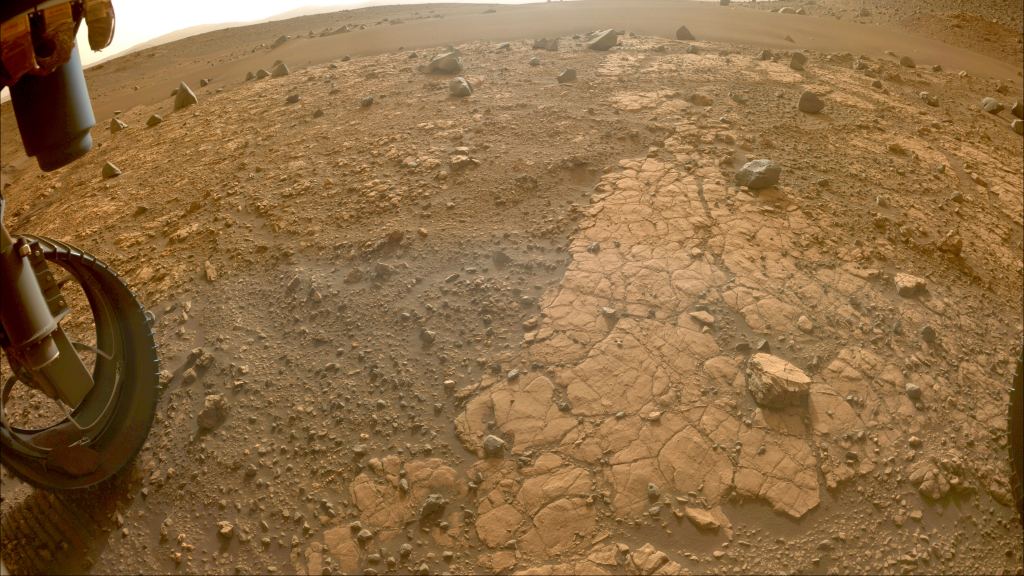NASA’s rolling geology robot shared a great image of sandstone that it found on Mars in Jezero Crater. It’s in a region called “Yori Pass”, which is part of an ancient river delta. Perseverance will take rock samples there for the upcoming Sample Return Mission.
They should tell more about what happened with water in this region. And maybe they’ll show evidence of life. What’s So Important about Sandstone? Most of us have run across sandstone at one time or another here on Earth.
It’s a rock formed when water carries sand from one place to another and deposits it. This could be in a lake or ocean environment, on an ancient beach, or along the edges of rivers. Some sandstones are also created when the wind blows sand into dunes.
Over time, all these sand layers harden into solid rock. That rock tells a chemical and physical story about the conditions at the time it was laid down. A sandstone formation on Earth found in the Valley of Fire Nevada State Park.
This area was once covered by an inland sea that receded and left behind sand deposits. Winds deposited more sand in the area, and the layers hardened into rock. Courtesy United States Geological Survey.
On Mars, both types of sandstone exist. However, in this particular area of Jezero Crater, flowing water deposited sand and small pebbles. Here on Earth, that kind of action also included organic materials such as plants and animals.
While we haven’t yet found evidence for that on Mars, it does raise interesting questions about the possibilities for life. “We often prioritize the study of fine-grained sedimentary rocks like this one in our search for organics and potential biosignatures,” said Katie Stack Morgan, Perseverance deputy project scientist at NASA’s Jet Propulsion Laboratory in Southern California. “What’s especially interesting about the Yori Pass outcrop is that it is laterally equivalent to ‘Hogwallow Flats,’ where we found very fine-grained sedimentary rocks.
That means that the rock bed is located at the same elevation as Hogwallow, and has a large, traceable footprint visible on the surface. ” Sandstone in Hogwallow Flats, where Perseverance visited earlier in 2022. The rocks are very fine-grained sandstone.
Courtesy NASA/JPL-Caltech/ASU Hogwallow Flats is a region where Perseverance also studied sandstones. As mentioned above, when water deposits sand and other rocks, it carries along other stuff. It all becomes part of the rock record, too.
In particular, Martian clay and mudstones interest planetary scientists. That’s because clays can “bind” organic molecules to themselves and protect them from environmental degradation. So, the study of Martian sandstones remains a top priority as mission scientists put together a clearer picture of the planet’s ancient past.
Water and the Hunt for Life Perseverance, along with the other Mars probes on the surface, continues its search for evidence of flowing water. That’s not surprising, since a major background theme of the mission is to follow the water. Rocks that come into contact with water always give physical and chemical evidence of that encounter.
If there was any life in that watery environment, scientists hope that Perseverance will gather biosignatures that they can study. Or, failing to find life signs, the rover may find organic molecules that indicate the possibility of life. Organic molecules are compounds of mostly carbon and usually include hydrogen and oxygen atoms.
They may also have nitrogen, phosphorus, and sulfur. A wide variety of processes can produce organic molecules—they aren’t always due to life. But, they are all chemical building blocks of life.
So, if they show up in a chemical analysis of rocks, then they could be biosignatures. They can also be signs of some other process that occurred on the planet in the past. A view from Curiosity of sandstone and other types of rocks in Gale Crater.
This image is from a place where the rover stopped called “the Kimberley”. Courtesy: NASA/JPL-Caltech Now, the Curiosity rover in Gale Crater has found these chemical building blocks of life in its searches. So, if the organic molecules were there, then perhaps they also existed at Jezero Crater where Perseverance is rolling along in its ongoing mission.
That also includes the in-depth study of rocks, collecting samples, and gathering information that Mars explorers can use when they get to the Red Planet. For More Information NASA’s Perseverance Rover Investigates Intriguing Martian BedrockFine-Grained Rocks at Hogwallow FlatsMars Perseverance Science Objectives The post Perseverance has Found a Nice Patch of Sandstone on Mars appeared first on Universe Today. .
From: universetoday
URL: https://www.universetoday.com/158713/perseverance-has-found-a-nice-patch-of-sandstone-on-mars/



